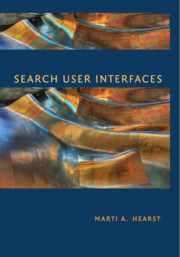Book contents
- Frontmatter
- Contents
- Preface
- 1 The Design of Search User Interfaces
- 2 The Evaluation of Search User Interfaces
- 3 Models of the Information Seeking Process
- 4 Query Specification
- 5 Presentation of Search Results
- 6 Query Reformulation
- 7 Supporting the Search Process
- 8 Integrating Navigation with Search
- 9 Personalization in Search
- 10 Information Visualization for Search Interfaces
- 11 Information Visualization for Text Analysis
- 12 Emerging Trends in Search Interfaces
- Appendix: Additional Copyright Notices
- Bibliography
- Index
- Author Index
- Plate section
5 - Presentation of Search Results
Published online by Cambridge University Press: 05 March 2013
- Frontmatter
- Contents
- Preface
- 1 The Design of Search User Interfaces
- 2 The Evaluation of Search User Interfaces
- 3 Models of the Information Seeking Process
- 4 Query Specification
- 5 Presentation of Search Results
- 6 Query Reformulation
- 7 Supporting the Search Process
- 8 Integrating Navigation with Search
- 9 Personalization in Search
- 10 Information Visualization for Search Interfaces
- 11 Information Visualization for Text Analysis
- 12 Emerging Trends in Search Interfaces
- Appendix: Additional Copyright Notices
- Bibliography
- Index
- Author Index
- Plate section
Summary
This chapter describes interfaces for the search results presentation portion of the information seeking process, focusing for the most part on ideas that are currently in use.
Document Surrogates
The most common way that search results are displayed is as a vertical list of information summarizing the retrieved documents. (These search results listings are often known as “search engine results pages,” or SERPs, in industry.) Typically, an item in the results list consists of the document's title and a set of important metadata, such as date, author, source (URL), and length of the article, along with a brief summary of a relevant portion of the document (see Figure 5.1). The representation for a document within a results listing is often called a search hit. This collection of information is sometimes referred to as the document surrogate. Marchionini and White (2008) note that document surrogates are summary information intended to help the user understand the primary object, as opposed to metadata more broadly construed, which can also serve this purpose but is often more tailored towards use by computer programs.
The quality of the document surrogate has a strong effect on the ability of the searcher to judge the relevance of the document. Even the most relevant document is unlikely to be selected if the title is uninformative or misleading. (Some Web search algorithms try to capture the quality of the title description as part of the ranking score.) The descriptiveness of the summary is also very important and is discussed in detail below.
- Type
- Chapter
- Information
- Search User Interfaces , pp. 120 - 140Publisher: Cambridge University PressPrint publication year: 2009
- 1
- Cited by



